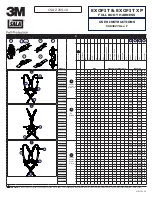
20
A P P L I C A T I O N
E N
▷
Using self-curing synthetic material [A],
“
detachably
”
connect the tracing tablet [1] with
the tray. The synthetic material must have com-
plete contact with the lateral notches of the tab-
lets, yet may not encase the notch from above,
as otherwise the tablet cannot be detached.
Fig. 4
Mandibular tray with tracing tablet
▷
Affix alignment clamp [6] with locking screw [7]
to tracing tablet [1].
Fig. 5
Affixing the alignment clamp
To mount the tracing ball on the individual func-
tional tray of the maxilla:
▷
Select long or short tracing ball depending on
space vertically available (here: Tracing ball,
long [4]).
▷
Screw tracing ball together with lock nut [4a]
about halfway into tracer mounting.
This leaves enough threads in both rotation
directions for subsequent adjustment.
▷
Protect the threads of the tracing ball facing
towards the palatinal side with wax or a piece of
the plastic hose [12].
▷
Screw in retention screws [3a] of tracer mount-
ing [3] to the stop. Insulate the threads with
vaseline (petroleum jelly).
Fig. 6
Schematic diagram of lock
▷
Position tracing ball [4] (with tracer mounting)
in alignment clamp [6] maximal 6 mm frontal to
chewing center and vertical to the tracing plate,
and then lock it with the screw to the alignment
clamp [6a].
▷
Apply autopolymerizate to the maxillary spoon
in the chewing center area, so that is runs fron-
tal.
▷
Close the articulator.
The tracer mounting is embedded in the autopo-
lymerizate of the maxillary spoon.
1
A
7
6
9
7
6
3
4
3a
6a
4a
















































